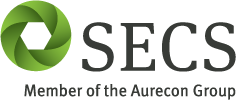The potential environmental receptors for a marine environment will include examination of benthic communities, rocky shore communities, mangroves, phytoplankton, corals, seagrasses, and RAMSAR wetlands, neighbouring industrial marine water intakes, aquaculture facilities, marine facilities, trans-boundary issues etc. In the marine environment, hydrodynamic modeling is a “must have” tool.
One of the 2D/3D Hydrodynamic Modeling can be carried out using a Delft 3D systems. Delft 3D is a flexible integrated modeling suite, which simulates two-dimensional (in either the horizontal or a vertical plane) and three-dimensional flow, sediment transport and morphology, waves, water quality and ecology and is capable of handling the interactions between these processes.
Some key features of the Delft 3D are:
– the suite give direct access to state-of-the-art process knowledge, accumulated and developed at one of the world’s renowned hydraulic institutes
– the Graphical User Interface (GUI)
– all programmes show a high degree of integration and interoperability
The Delft 3D is well-tested and validated. It allows to simulate the interaction of water, sediment, ecology and water quality in time and space. There are 7 modules in the Delft 3D namely:
a) D-Flow
b) D-Morphology
c) D-Waves
d) D-Water Quality
e) D-Sediment Transport
f) D-Ecology
g) D-Particle Tracking
D-Flow
D-Morphology
D-Waves
D-Water Quality
D-Sediment Transport
D-Ecology
D-Particle Tracking
This programme simulates non-steady flows in relatively shallow water. It incorporates the effects of tides, winds, air pressure, density differences (due to salinity and temperature), waves, turbulence and drying and flooding. With the integrated heat and mass transport solver, stratified hydrodynamics have been built into the model. It has a standard programme that covers curvilinear and rectilinear grids, full 2D hydrostatic flow, advection-diffusion module for salinity, temperature and substances, density driven flows, float tracking, meterological influences, on-line visualisation and wave-current interaction.
The 3D flow and turbulence modelling, spherical grids, domain decomposition (connect multiple grids, refinement in both horizontal and vertical direction allowed), structures (weirs, gates, floating structures, semi-transparent structures) and horizontal large eddy simulations (sub-grid turbulence in horizontal).
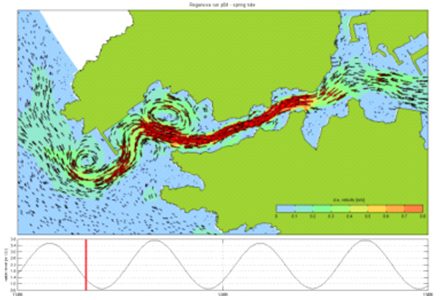
Example detailed modelling of flow circulation to support nautical and safety studies, Reganossa, Spain (extracted from Delft 3D website)
This programme computes sediment transport (both suspended and bed total load) and morphological changes for an arbitrary number of cohesive and non-cohesive fractions. Both currents and waves act as driving forces and a wide variety of transport formulae have been incorporated. For the suspended load, the programme connects to the 2D or 3D advection-diffusion solver of the D-flow programme. There is a dynamic feedback with the D-flow and D-waves programmes, which allows the flows and waves to adjust themselves to the local bathymetry and allows for simulations on any time scale from days to centuries. It keeps track of bed composition and thus, build up a stratigraphic record. The programme allows simulation of dumping scenarios.
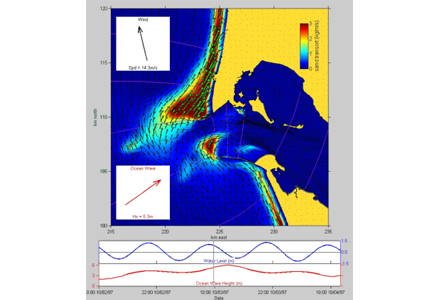
Example sand transport during storm event, Columbia River Estuary and Coast, USA(extracted from Delft 3D website)
The programme computes the non-steady propagation of short-crested waves over an uneven bottom, considering wind action, energy dissipation due to bottom friction, wave breaking, refraction (due to bottom topography, water levels and flow fields) , shoaling and directional spreading.
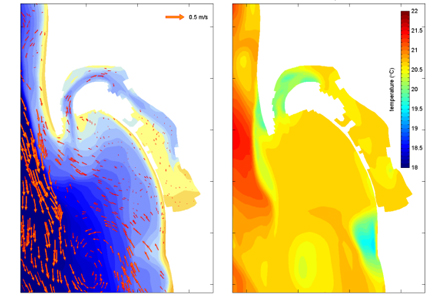
Example surface currents and surface temperature, San Diego Bay, USA (extracted from Delft 3D website)
This programme simulates the far and mid-field water and sediment quality due to a variety of transport and water quality processes. It has an extensive library of standardised process formulations with the user-selected substances. The model allows the simulation of decay of BOD and nitrification, elementary growth of algae and nutrient cycling, exchange of substances with the atmosphere, adsorption and desorption of contaminant substances and the deposition and re-suspension of particles and adsorbed substances to and from the bed.
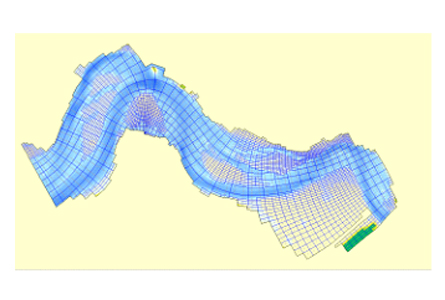
Impression of the DIDO tool for grid aggregation for water quality computations(extracted from Delft 3D website)
This is a sub programme of D-Water Quality as it simulates the transport, erosion and settling of cohesive and non-cohesive, organic or inorganic, suspended or bed sediments. This programme considers different particulate fractions independently.
A variety of algae growth and nutrient dynamics programmes have been incorporated. The governing processes of biotic and abiotic ecosystems and the interaction between these have been inserted into the process library, all of which are relevant to the study of eutrophication.
This programme estimates the dynamic, spatial concentration distribution of individual particles by following their tracks in time.
